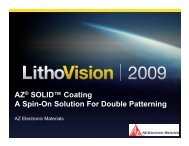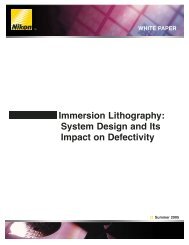Immersion lithographic performance and S610C ... - Nikon Precision
Immersion lithographic performance and S610C ... - Nikon Precision
Immersion lithographic performance and S610C ... - Nikon Precision
Create successful ePaper yourself
Turn your PDF publications into a flip-book with our unique Google optimized e-Paper software.
<strong>Immersion</strong> <strong>lithographic</strong> <strong>performance</strong> <strong>and</strong><br />
<strong>S610C</strong> production integration at AMD<br />
Rolf Seltmann, Marc Staples, Holger Bald,<br />
Udo Nothelfer, Harry Levinson
Outline<br />
• <strong>Immersion</strong> challenges <strong>and</strong> prior experience at AMD<br />
• Overlay<br />
• Defectivity<br />
• <strong>Nikon</strong> <strong>S610C</strong> in AMD‘s 45 nm manufacturing<br />
• Overlay <strong>performance</strong><br />
• Focus <strong>performance</strong><br />
• Defectivity<br />
• The pattern orientation issue<br />
• Matching <strong>performance</strong><br />
• Product <strong>performance</strong><br />
• Summary/ conclusion<br />
2 | <strong>Nikon</strong> LithoVision | 22 January 2009
Introduction<br />
• The logic 45 nm technology has pitches between 130 nm <strong>and</strong><br />
160 nm.<br />
• For dry tools, this corresponds to a k 1 between 0.31 <strong>and</strong><br />
0.38.<br />
• With immersion we could delay the use of double<br />
patterning <strong>and</strong> a lot of design rule restrictions.<br />
• <strong>Immersion</strong> opens the door to k 1 in the range of 0.40<br />
<strong>and</strong> above!<br />
• But what about defectivity, overlay?<br />
• Some people questioned whether immersion was mature<br />
enough to put into production in 2007!<br />
3 | <strong>Nikon</strong> LithoVision | 22 January 2009
<strong>Immersion</strong> challenges: overlay<br />
Indeed, early immersion tools had noticeable non-linear<br />
signatures:<br />
Advanced dry tool<br />
Early <strong>Immersion</strong><br />
State of the art<br />
immersion<br />
4.0 nm, 3σ 9.0 nm, 3σ 4.5 nm, 3σ<br />
4 | <strong>Nikon</strong> LithoVision | 22 January 2009
But: even with non-linear chuck-signatures we<br />
can achieve great overlay results<br />
• Measure signature difference between scanner for layer 1 <strong>and</strong><br />
scanner for layer 2.<br />
• Signatures are time dependent: S(t 1 ), S(t 2 ), ...S(t n ).<br />
• S = set of overlay error vectors.<br />
• Apply a signature S(t i ) depending on the history of layer 1/ layer.2<br />
exposure.<br />
• This scenario can be extended to match to tools with 2 chucks.<br />
Mixed tool, uncorrected<br />
Mixed tool, corrected<br />
Dedicated tool/chuck<br />
S(ti)<br />
Single digit<br />
numbers in<br />
both cases<br />
5 | <strong>Nikon</strong> LithoVision | 22 January 2009
<strong>Immersion</strong> challenges: defectivity<br />
Is immersion by definition worse than dry?<br />
Not necessarily!<br />
If one has good monitoring in place, <strong>and</strong> if appropriate changes made, even<br />
lower defect counts (at smaller defect sizes) are possible !<br />
The pareto changes but the overall number is even lower!<br />
6 | <strong>Nikon</strong> LithoVision | 22 January 2009
<strong>S610C</strong> <strong>performance</strong><br />
7 | <strong>Nikon</strong> LithoVision | 22 January 2009
Overlay Performance of the <strong>S610C</strong><br />
Local fill technology<br />
promises excellent overlay<br />
However, < 5 nm overlay numbers required<br />
more:<br />
• Interferometer improvements (filter<br />
algorithm).<br />
• Improved airflow (more homogeneous).<br />
• Reduced environmental effects (chamber<br />
ceiling, relocated temperature sensor, ...).<br />
Overlay-residuals, contact to gate<br />
Interferometer, airflow,<br />
lower environmental<br />
effects<br />
7.5nm<br />
5nm<br />
8 | <strong>Nikon</strong> LithoVision | 22 January 2009
Focus <strong>performance</strong>: early S610 data<br />
Edge die leveling is always a challenge!<br />
<strong>Nikon</strong> did a lot of testing <strong>and</strong> optimization:<br />
• Wafer edge autofocus algorithm improvement.<br />
• Stage control mode, data filtering.<br />
• Autofocus mapping route optimization<br />
• + some other small incremental steps<br />
...with big success!<br />
9 | <strong>Nikon</strong> LithoVision | 22 January 2009
Focus <strong>performance</strong> after improvements<br />
before<br />
after<br />
Please note: different<br />
scale on the two maps<br />
3σ = 40 nm 3σ = 24 nm<br />
10 | <strong>Nikon</strong> LithoVision | 22 January 2009
Focus <strong>performance</strong> after improvements<br />
• A 3σ value of 24 nm is an excellent achievement.<br />
• Good mean focus stability (
Defectivity: a basic question<br />
Local Fill Technology shows<br />
excellent overlay, ....<br />
but what about water loss?<br />
?<br />
An unguarded water film is quite challenging <strong>and</strong> requires<br />
a very robust nozzle design.<br />
12 | <strong>Nikon</strong> LithoVision | 22 January 2009
The joint way to low level defectivity<br />
Essential steps toward good defectivity:<br />
• Use material with a high dynamic receding contact angle<br />
• Wafer edge / bevel optimization<br />
• Nozzle optimization is the key!<br />
• Smooth nozzle surface; prevents sticking of particles<br />
• Proper cleaning / nozzle flushing execution<br />
• Strong collaboration between <strong>Nikon</strong> <strong>and</strong> the customer!<br />
13 | <strong>Nikon</strong> LithoVision | 22 January 2009
The joint way to low level defectivity<br />
as it was today target<br />
• At the beginning<br />
of the joint<br />
project,<br />
immersion<br />
defects were<br />
dominating.<br />
• Today, they are<br />
equal or lower<br />
than other<br />
(mostly track<br />
related) defects<br />
14 | <strong>Nikon</strong> LithoVision | 22 January 2009
Pattern orientation <strong>and</strong> its impact<br />
193 nm dry<br />
<strong>Nikon</strong><br />
<strong>Immersion</strong><br />
F<br />
It‘s a one-time effort to get the logistics<br />
done. Not nice but not really a big deal!<br />
<strong>Immersion</strong><br />
Company A • If you also have scanners from Company A<br />
you can‘t share reticles anymore.<br />
F<br />
• Layer dedication requires more complex<br />
factory management systems.<br />
• In a transition phase, there are extra costs for masks.<br />
• Technology start-up, new fabs.<br />
• In high volume manufacturing, dedication by tool type is more<br />
manageable.<br />
15 | <strong>Nikon</strong> LithoVision | 22 January 2009
Can we use tools from different vendors for the<br />
same product? The overlay question<br />
• For manufacturing flexibility it is desirable to run even critical layers<br />
in a mixed tool scenario.<br />
• How much overlay <strong>performance</strong> do we give up if we run in mixed<br />
mode, ultimately mixed between different vendors?<br />
Higher order matching (both field <strong>and</strong> grid) is the key!<br />
• Grids were matched to fab<br />
reference better than 7/6 nm.<br />
• No clear systematics anymore!<br />
Single shot correction as<br />
an additional knob not used<br />
6.8/5.6nm (3σ)<br />
16 | <strong>Nikon</strong> LithoVision | 22 January 2009
Production data in the matched scenario<br />
Field residuals<br />
Wafer overlay<br />
Single machine<br />
S610 – baseline,<br />
initial matching<br />
S610-baseline second<br />
matching iteration<br />
Wafer overlay map uses different scale than field residual maps<br />
17 | <strong>Nikon</strong> LithoVision | 22 January 2009
Matched machine overlay statistics<br />
• RSS addition of the<br />
individual terms<br />
• Field residuals include<br />
the mask contribution<br />
• Other contains wafer to<br />
wafer + correctables<br />
• If matching is done accurately, the <strong>performance</strong> ∆ is just 20% (same<br />
vendor) <strong>and</strong> 30% (mixed vendor) compared to dedicated machines.<br />
• Slightly higher number for different vendor is due to different, noncorrectable<br />
grid <strong>and</strong> lens fingerprint.<br />
• Based on great <strong>performance</strong>, we can run all critical layer<br />
combinations in mixed mode (except one super-critical layer<br />
combination).<br />
18 | <strong>Nikon</strong> LithoVision | 22 January 2009
OPC Matching of <strong>S610C</strong> to existing<br />
45 nm process<br />
• Even if different reticles have to be used for resource <strong>and</strong> simplicity<br />
reasons, it is desirable to use the same OPC-model for different<br />
vendors tooling.<br />
• Matching method.<br />
<br />
<br />
<br />
<br />
<br />
<br />
Expose wafer with same nominal illumination settings on the<br />
reference tool <strong>and</strong> the S610; measure 1D <strong>and</strong> 2D patterns.<br />
Simulate the response CD. Take different pupil shapes into<br />
account.<br />
Calibrate the model using the measurements.<br />
Determine a set of optimized illumination settings for the <strong>S610C</strong>.<br />
Simulate effects of small illumination changes <strong>and</strong> find optimized<br />
illumination settings.<br />
Verify optimized settings.<br />
19 | <strong>Nikon</strong> LithoVision | 22 January 2009
OPC matching result example for 45 nm<br />
metal application<br />
Initial Space through pitch deviation of<br />
S610 from reference tool<br />
S610 Space through pitch deviation from<br />
reference tool after matching<br />
2<br />
6.00<br />
0<br />
4.00<br />
Deviation / nm<br />
-2<br />
-4<br />
-6<br />
Deviation / nm<br />
2.00<br />
0.00<br />
-2.00<br />
-8<br />
-4.00<br />
-10<br />
0 100 200 300 400 500 600 700 800<br />
-6.00<br />
0 200 400 600 800<br />
Pitch /nm<br />
Pitch / nm<br />
• Changes up to 20% on individual knobs necessary<br />
• Final result is noise dominated<br />
20 | <strong>Nikon</strong> LithoVision | 22 January 2009
Electrical <strong>performance</strong> of lots processed via <strong>S610C</strong><br />
• We successfully run 45 nm lots on the <strong>S610C</strong>.<br />
• Most critical layers: contact <strong>and</strong> gate (impact on yield, speed).<br />
• We achieved good yield <strong>and</strong> great speed.<br />
leakage<br />
S610<br />
speed<br />
• Other layers with hard requirements on overlay <strong>and</strong> CD control are<br />
running on the tool as I speak.<br />
21 | <strong>Nikon</strong> LithoVision | 22 January 2009
Conclusion /summary<br />
• The <strong>S610C</strong> was introduced into AMD‘s well-established 45 nm technology.<br />
• In close cooperation between NIKON CORPORATION <strong>and</strong> AMD, all<br />
<strong>lithographic</strong> metrics were improved significantly within the project.<br />
• We achieved world class focus <strong>and</strong> overlay data.<br />
• Defectivity, which required process optimization, was improved to a<br />
level that justifies the use of the tool in high end production.<br />
• Cooperation continues to get world class <strong>performance</strong> as well.<br />
• We could prove very good matching <strong>performance</strong> to our FAB-baseline,<br />
both with respect to overlay <strong>and</strong> OPC.<br />
• However, issues related to the pattern orientation must be addressed.<br />
• We have demonstrated great product <strong>performance</strong> (yield, speed).<br />
22 | <strong>Nikon</strong> LithoVision | 22 January 2009













